
Gensokyo-llm
开源的智能体项目 支持6种聊天平台 Onebotv11一对多连接 流式信息 agent 对话keyboard气泡生成 支持10+大模型接口(持续更新) 具有将多种大模型接口转化为带有上下文的通用格式的能力.
Stars: 92
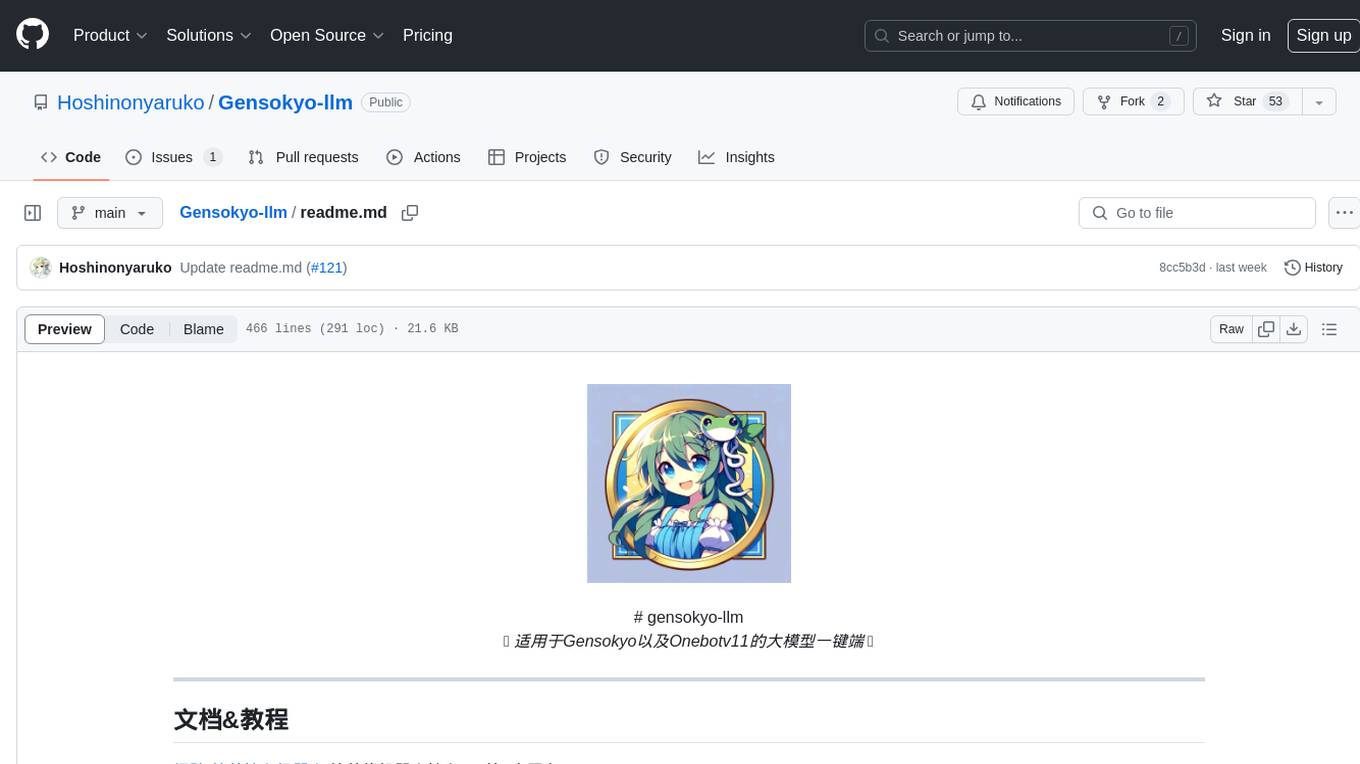
Gensokyo-llm is a tool designed for Gensokyo and Onebotv11, providing a one-click solution for large models. It supports various Onebotv11 standard frameworks, HTTP-API, and reverse WS. The tool is lightweight, with built-in SQLite for context maintenance and proxy support. It allows easy integration with the Gensokyo framework by configuring reverse HTTP and forward HTTP addresses. Users can set system settings, role cards, and context length. Additionally, it offers an openai original flavor API with automatic context. The tool can be used as an API or integrated with QQ channel robots. It supports converting GPT's SSE type and ensures memory safety in concurrent SSE environments. The tool also supports multiple users simultaneously transmitting SSE bidirectionally.
README:
✨ 适用于Gensokyo以及Onebotv11的大模型一键端 ✨
初阶-简单接入机器人:简单将机器人接入QQ等6大平台
中级-对接one-api教程:可视化管理大模型api
支持所有Onebotv11标准框架.支持http-api和反向ws,支持流式发送,多配置文件(多提示词)
超小体积,内置sqlite维护上下文,支持proxy,
可一键对接Gensokyo框架 仅需配置反向http地址用于接收信息,正向http地址用于调用发送api
基于sqlite数据库自动维系上下文,对话模式中,使用重置 命令即可重置
可设置system,角色卡,上下文长度,
同时对外提供带有自动上下文的openai原始风味api(经典3参数,id,parent id,messgae)
可作为api运行,也可一键接入QQ频道机器人QQ机器人开放平台
可转换gpt的sse类型,递增还是只发新增的sse
并发环境下的sse内存安全,支持维持多用户同时双向sse传输
腾讯混元
腾讯元器
百度文心
阿里通义
清华智谱
字节火山(豆包)
OpenAI
groQ
Rwkv runner
One-API
将这些平台的api转换为统一的api结构,并提供了上下文,支持sse方式返回
通过在yml设置相应平台的token,设置AllApi=true,可以同时进行切换调用.
多重完备安全措施,尽可能保证开发者和llm应用安全.
可设置多轮模拟QA强化角色提示词,可自定义重置回复,安全词回复,第一重安全措施
支持多gsk-llm互联,形成ai-agent类应用,如一个llm为另一个llm整理提示词,审核提示词,第二重安全措施
向量安全词列表,基于向量相似度的敏感拦截词列表,先于文本替换进行,第三重安全措施
AhoCorasick算法实现的超高效文本IN-Out替换规则,可大量替换n个关键词到各自对应的新关键词,第四重安全措施
结果可再次通过百度-腾讯,文本审核接口,第五重安全措施
日志全面记录,命令行参数-test 从test.txt快速跑安全自测脚本,
命令行 -mlog 将当前储存的所有日志进行QA格式化,每日审验,从实际场景提炼新安全规则,不断增加安全性,第六重安全措施
语言过滤,允许llm只接受所指定的语言,自动将繁体转换为简体应用安全规则,在自己擅长的领域进行防守,第七重安全措施
提示词长度限制,用最原始的方式控制安全,阻止恶意用户构造长提示词,第八重安全措施
通过这些方法,打造尽可能安全llm对话机器人。
文本IN-OUT双层替换,可自行实现内部提示词动态替换,修改,更安全强大
基于sqlite设计的向量数据表结构,可使用缓存来省钱.自定义缓存命中率,精准度.
针对高效高性能高QPS场景优化的专门场景应用,没有冗余功能和指令,全面围绕数字人设计.
使用命令行运行gensokyo-llm可执行程序
配置config.yml 启动,后监听 port 端口 提供/conversation api
支持中间件开发,在gensokyo框架层到gensokyo-llm的http请求之间,可开发中间件实现向量拓展,数据库拓展,动态修改用户问题.
支持反向ws连接,支持同时连接多个onebotv11的http-api
本文档提供了关于API接口的调用方法和配置文件的格式说明,帮助用户正确使用和配置。
本系统的 conversation 和 gensokyo 端点支持通过查询参数 ?prompt=xxx 来指定特定的配置。
-
prompt参数允许用户指定位于执行文件(exe)的prompts文件夹下的配置YAML文件。使用该参数可以动态地调整API行为和返回内容。 -
prompts文件夹需要有一个默认的keyboard.yml用于生成气泡.其系统提示词需要遵循json气泡生成器的prompts规则.
配置文件应遵循以下YAML格式。这里提供了一个示例配置文件,展示了如何定义不同角色的对话内容:
Prompt:
- role: "system"
content: "Welcome to the system. How can I assist you today?"
- role: "user"
content: "I need help with my account."
- role: "assistant"
content: "I can help you with that. What seems to be the problem?"
- role: "user"
content: "aaaaaaaaaa!"
- role: "assistant"
content: "ooooooooo?"
settings:
# 以下是通用配置项 和config.yml相同
useSse: true
port: 46233当向 /gensokyo 端点发起请求时,系统支持附加 prompt 参数和 api 参数。api 参数允许指定如 /conversation_ernie 这类的完整端点。启用此功能需在配置中开启 allapi 选项。
示例请求:
GET /gensokyo?prompt=example&api=conversation_ernie支持端点列表:(需配置:allApi : true)
http.HandleFunc("/conversation_gpt", app.ChatHandlerChatgpt)
http.HandleFunc("/conversation_hunyuan", app.ChatHandlerHunyuan)
http.HandleFunc("/conversation_ernie", app.ChatHandlerErnie)
http.HandleFunc("/conversation_rwkv", app.ChatHandlerRwkv)
http.HandleFunc("/conversation_tyqw", app.ChatHandlerTyqw)
http.HandleFunc("/conversation_glm", app.ChatHandlerGlm)与 /gensokyo 类似,/conversation 端点支持附加 prompt 参数。
示例请求:
GET /conversation?prompt=example提供的 prompt 参数将引用可执行文件目录下的 /prompts 文件夹中相应的 YAML 文件(例如 xxxx.yml,其中 xxxx 是 prompt 参数的值)。
通过编写大量的prompts的yml文件,你可以实现角色卡切换,同一角色下,你可以实现故事情节和不同场景切换。
YAML 文件的配置格式请参考 YAML配置文件格式 部分。以下列出的配置项支持在请求中动态覆盖:
每一种参数都实现了配置覆盖
如果有疏漏,需要支持配置覆盖,请提交 issue。
所有的bool值在配置文件覆盖的yml中必须指定,否则将会被认为是false.
动态配置覆盖是一个我自己构思的特性,利用这个特性,可以实现配置文件之间的递归,举例,你可以在自己的中间件传递prompt=a,在a.yml中指定Lotus为调用自身,并在lotus地址中指定下一个prompt参数为b,b指定c,c指定d,以此类推.
本项目实现了一种提示词控制流,一种可控上下文构造方式,基于本项目实现的多配置文件,可实现配置文件之间按条件跳转、切换,
实现了让用户在多个提示词中,按照一些条件,有顺序,可选择的,在多套提示词中进行流转,实现文字恋爱游戏、探险游戏、非连续性多支线的故事剧情、类工作流提示词系统。
- [x] promptMarks:
- BranchName: "去逛街路上"
Keywords: ["坐车", "走路", "触发"]
- BranchName: "在家准备"
Keywords: ["等一下", "慢慢", "准备"]
- [x] enhancedQA: true
- [x] promptChoicesQ:
- Round: 1
ReplaceText: "回家吧"
Keywords: ["我累了", "不想去了"]
- Round: 2
ReplaceText: "我们打车去"
Keywords: ["快点去", "想去", "早点"]
- Round: 3
ReplaceText: "我们走着去"
Keywords: ["不着急", "等下"]
- Round: 1
ReplaceText: "放松一下"
Keywords: [] # 相当于 enhancedChoices = false
- [x] promptChoicesA: 同上。
- [x] promptCoverQ: 只有Q没有A,格式同上,Choices是附加,cover是覆盖。
- [x] promptCoverA: # 同上
- [x] switchOnQ:
- round: 1
switch: ["故事退出分支", "下一个分支"]
keywords: ["不想", "累了", "想", "不累"]
- [x] switchOnA:
- round: 1
switch: ["晚上分支"]
keywords: ["时间不早了"]
- [x] exitOnQ:
- round: 1
keywords: ["退出", "忘了吧", "重置", "无聊"]
- [x] exitOnA:
- round: 1
keywords: ["退出", "我是一个AI", "我是一个人工", "我是一个基于"]
- [x] envType: 0 # 0=不使用场景描述, 1=在本轮llm回复前发送场景描述, 2=在本轮llm回复后发送场景描述, 场景描述支持[image:xxx][pic:xxx][图片:xxx][背景:xxx]标签, xxx为相对或绝对路径, 需在exe运行目录下
- [x] envPics: [] # 现阶段ai速度太慢,人工指定,数组代表多个,每个数组成员以1: 2: 开始代表对应第几轮.
- [x] envContents: [] # 如果要跳过某个轮次,直接指定文字是2: 图片也是2: 代表本轮文图是空的.
- [x] promptChanceQ:
- probability: 50
text: "让我们休息一下"
- probability: 30
text: "继续前进"
- probability: 70
text: "停下来看看周围"
- probability: 10
text: "尝试一些新东西"以上参数均位于多配置文件的settings部分,你可以决定每个场景的提示词长度,每个场景的长度promptMarksLength,来控制剧情的颗粒度。
故事模式触发方式一,中间件控制,自行调用/gensokyo端口附加不同的prompt参数,手动切断
在gsk-llm设置ob11机器人框架的http api地址,ob11插件应用端不负责发信息,只是根据信息内容进行条件判断,作为控制中间件,给开发者自己控制条件的开发自由度。
故事模式触发方式二,通过配置默认配置文件config.yml的switchOnQ和switchOnA,可以根据关键词自动切换分支,
结合prompt参数中配置文件的自己推进故事走向的能力,可以实现基础的,以提示词为主的ai故事情节,此外还需要为每一个prompt.yml设计对应的-keyboard.yml,生成气泡。
promptMarks的keywords为[]代表按promptMarksLength来切换提示词文件,promptMarksLength代表本提示词文件维持的上下文长度,
当promptMarksLength小于0时,会从promptMarks中读取之后的分支,并从中随机一个切换,当promptMarkType=1时,
1=按条件触发,promptMarksLength达到时也触发.
识别到用户和模型说出标记就会触发这个支线(需要自行写好提示词,让llm能根据条件说出.)
你可以使用当前故事片段的,系统提示词,QA,来引导AI输出与你约定的切换词,从而实现为每个目标分支设计多个触发词,让大模型自行决定故事的发展方向。
当enhancedQA为false时,会将配置文件中的预定义的QA加入到用户QA的顶部,存在于llm的记忆当中(不影响整体对话走向)形成弱影响
当enhancedQA为true时,我尝试将配置文件中预定义QA的位置从顶部下移到用户当前对话的前方,但效果不理想,
目前是会与当前用户的历史QA进行混合和融合,实现对用户输入进行一定程度的引导,从而左右故事进程的走向。
引入了“配置控制流”参数,这是一种相比ai-agent灵活性更低,但剧情可控性更高,生成速度和成本更低的方式。
promptChoicesQ & promptChoicesA 文档: 流程控制-promptchoicesQ 流程控制-promptCoverQ 流程控制-promptChanceQ
switchOnQ代表在Q中寻找到匹配文本时切换当前分支,switchOnA同理,其配置方式和promptChoices一致.
exitOnQ则是代表检测到指定关键字会退出当前的分支。 流程控制-exitonQA
promptMarks和switchOnQ、switchOnA在功能上是相同的,都是根据关键字跳转分支,promptMarks先执行,不分轮次不分QA,switchOnQ和switchOnA更具体,区分Q和A,区分轮次,实现细节跳转。
如果有固定且不需要切换的分支,请设置该yml的promptMarksLength为99999
promptMarksLength : 99999
以避免错误的切换到不存在的分支,导致会话报错.
配置控制流简单直观,通过配置文件来管理对话逻辑,配置文件易于维护,非技术人员,如剧情编写者,可以直接学习配置文件规则,修改配置文件来更新对话逻辑,不需要编程知识。
剧情确定性高:给定相同的输入和配置,剧情走向是大体一致的,这对于确保对话剧情的连贯性和可预测性非常重要。
成本低,对上下文进行巧妙组合和替换,而不是多个ai同时处理,与普通对话消耗几乎等量的token,省钱。
速度快,像生成普通对话QA一样生成结果,像写游戏脚本一样编写剧情。
适用于个体开发者和小型开发团队的低成本ai故事、小说方案,低成本,高速度,高可控,效果随模型和提示词效果提升而直接提升。
对于对话剧情聊天场景,如果剧情较为固定,对话路径预设,且更新频率不高,使用配置控制流更适合,因为它提供了高度的可控性和易于理解的管理方式。
如果对话系统需要高度的互动性和个性化,或者剧情变化复杂,需要根据用户的具体反馈和行为动态调整,那么使用基于AI的agent方案可能更合适,它需要更高的技术投入和维护成本。
本节介绍了与API通信的具体终结点信息。
| 属性 | 详情 |
|---|---|
| URL | http://localhost:46230/conversation |
| 方法 | POST |
客户端应向服务器发送的请求体必须为JSON格式,以下表格详细列出了每个字段的数据类型及其描述。
| 字段名 | 类型 | 描述 |
|---|---|---|
message |
String | 用户发送的消息内容 |
conversationId |
String | 当前对话会话的唯一标识符 |
parentMessageId |
String | 与此消息关联的上一条消息的标识符 |
下面的JSON对象展示了向该API终结点发送请求时,请求体的结构:
{
"message": "我第一句话说的什么",
"conversationId": "07710821-ad06-408c-ba60-1a69bf3ca92a",
"parentMessageId": "73b144d2-a41f-4aeb-b3bb-8624f0e54ba6"
}该示例展示了如何构造一个包含消息内容、当前对话会话的唯一标识符以及上一条消息的标识符的请求体。这种格式确保了请求的数据不仅符合服务器的处理规则,同时也便于维护对话上下文的连贯性。
成功响应将返回状态码 200 和一个JSON对象,包含以下字段:
| 字段名 | 类型 | 描述 |
|---|---|---|
response |
String | 接口的响应消息内容 |
conversationId |
String | 当前对话的唯一标识符 |
messageId |
String | 当前消息的唯一标识符 |
details |
Object | 包含额外的使用详情 |
usage |
Object (在 details 中) |
使用详情,如令牌计数 |
{
"response": "回答内容",
"conversationId": "c9b8746d-aa8c-44b3-804a-bb5ad27f5b84",
"messageId": "36cc9422-da58-47ec-a25e-e8b8eceb47f5",
"details": {
"usage": {
"prompt_tokens": 88,
"completion_tokens": 2
}
}
}可在各种架构运行 (原生android暂不支持,sqlitev3需要cgo) 由于cgo编译比较复杂,arm平台,或者其他架构,可试图在对应系统架构下,自行本地编译
API方式调用 QQ频道直接接入
审核员请求参数
当需要将请求发给另一个 GSK LLM 作为审核员时,应该返回的 JSON 格式如下:
{"result":%s}这里的 %s 代表一个将被替换为具体浮点数值的占位符。
气泡生成请求结果
当请求另一个 GSK LLM 生成气泡时,应该返回的 JSON 格式如下:
["","",""]这表示气泡生成的结果是一个包含三个字符串的数组。这个格式用于在返回结果时指明三个不同的气泡,也可以少于或等于3个.
现已不再需要开多个gsk-llm实现类agent功能,基于新的多配置覆盖,prompt参数和lotus特性,可以自己请求自己实现气泡生成,故事推进等复杂特性.
GetAIPromptkeyboardPath可以是自身地址,可以带有prompt参数
当使用中间件指定prompt参数时,配置位于prompts文件夹,其格式xxx-keyboard.yml,若未使用中间件,请在path中指定prompts参数,并将相应的xxx.yml放在prompts文件夹下)
设置系统提示词的gsk-llm联合工作的/conversation地址,约定系统提示词需返回文本json数组(3个).
本项目参考了以下知名项目的思路,实现了一个简化的AI文本控制流配置格式.
-
Rasa
- 项目主页:Rasa
- GitHub地址:Rasa on GitHub
- Rasa是一个开源的机器学习框架,用于自动化文本和语音的对话。它让开发者能够构建复杂的聊天机器人,处理多轮对话,并支持自定义的对话管理策略。
- 它使用了一种名为“故事”的格式来定义对话的可能路径,这些故事基于用户的意图和前置条件来控制对话的流程。
-
Twine
- 项目主页:Twine
- GitHub地址:Twine on GitHub
- Twine是用于创建交互式故事的开源工具,它非常适合编写分支故事和视觉小说。它提供了一个直观的视觉编辑界面,允许创作者无需编程知识即可创作故事。
- 它允许作者编写基于选择的故事,其中故事的发展依赖于读者的决策。这是一种文本控制流的实现,用于叙述管理。
-
Inklewriter
- 项目主页,Ink on GitHub.
- 它是一个允许用户创建交互式故事的网页平台。它设计了ink语言,它是一个开源项目,用于编写交互式叙述和游戏。
For Tasks:
Click tags to check more tools for each tasksFor Jobs:
Alternative AI tools for Gensokyo-llm
Similar Open Source Tools

Gensokyo-llm
Gensokyo-llm is a tool designed for Gensokyo and Onebotv11, providing a one-click solution for large models. It supports various Onebotv11 standard frameworks, HTTP-API, and reverse WS. The tool is lightweight, with built-in SQLite for context maintenance and proxy support. It allows easy integration with the Gensokyo framework by configuring reverse HTTP and forward HTTP addresses. Users can set system settings, role cards, and context length. Additionally, it offers an openai original flavor API with automatic context. The tool can be used as an API or integrated with QQ channel robots. It supports converting GPT's SSE type and ensures memory safety in concurrent SSE environments. The tool also supports multiple users simultaneously transmitting SSE bidirectionally.
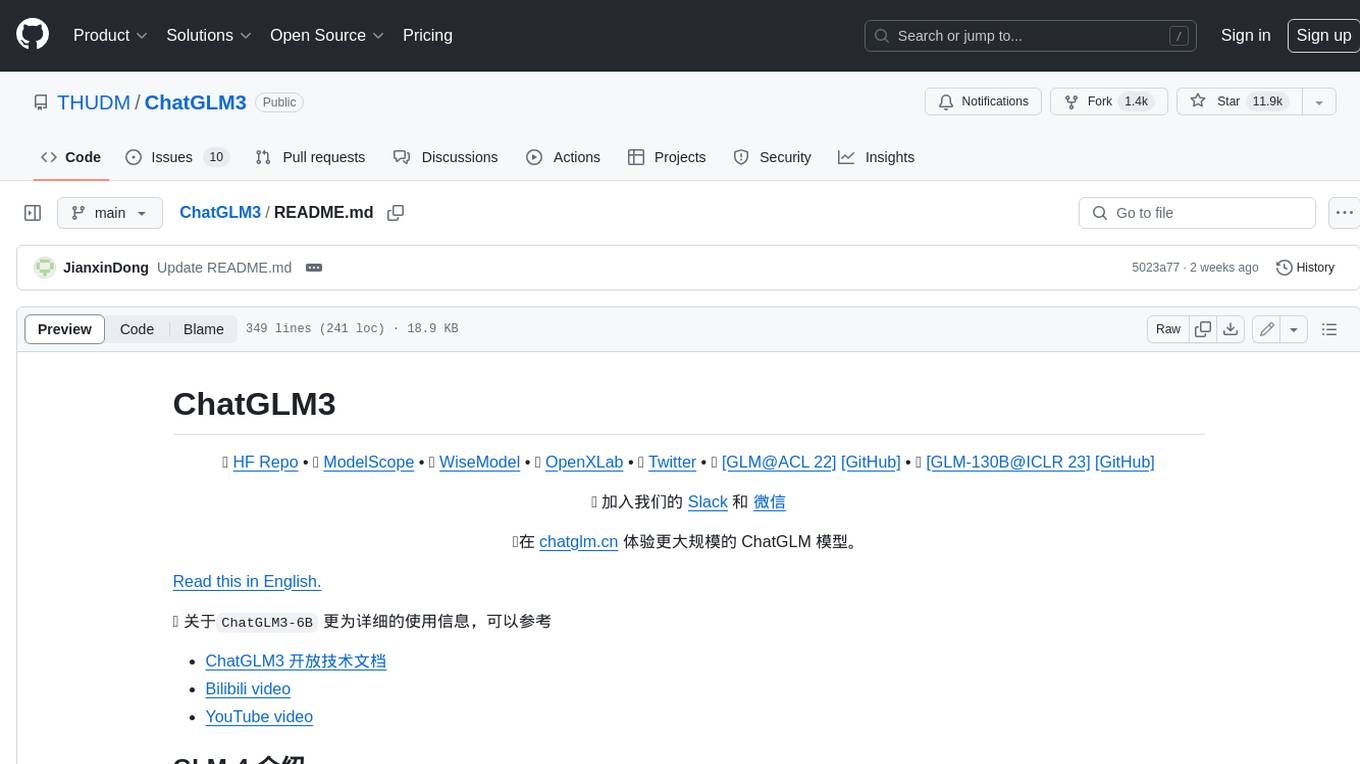
ChatGLM3
ChatGLM3 is a conversational pretrained model jointly released by Zhipu AI and THU's KEG Lab. ChatGLM3-6B is the open-sourced model in the ChatGLM3 series. It inherits the advantages of its predecessors, such as fluent conversation and low deployment threshold. In addition, ChatGLM3-6B introduces the following features: 1. A stronger foundation model: ChatGLM3-6B's foundation model ChatGLM3-6B-Base employs more diverse training data, more sufficient training steps, and more reasonable training strategies. Evaluation on datasets from different perspectives, such as semantics, mathematics, reasoning, code, and knowledge, shows that ChatGLM3-6B-Base has the strongest performance among foundation models below 10B parameters. 2. More complete functional support: ChatGLM3-6B adopts a newly designed prompt format, which supports not only normal multi-turn dialogue, but also complex scenarios such as tool invocation (Function Call), code execution (Code Interpreter), and Agent tasks. 3. A more comprehensive open-source sequence: In addition to the dialogue model ChatGLM3-6B, the foundation model ChatGLM3-6B-Base, the long-text dialogue model ChatGLM3-6B-32K, and ChatGLM3-6B-128K, which further enhances the long-text comprehension ability, are also open-sourced. All the above weights are completely open to academic research and are also allowed for free commercial use after filling out a questionnaire.
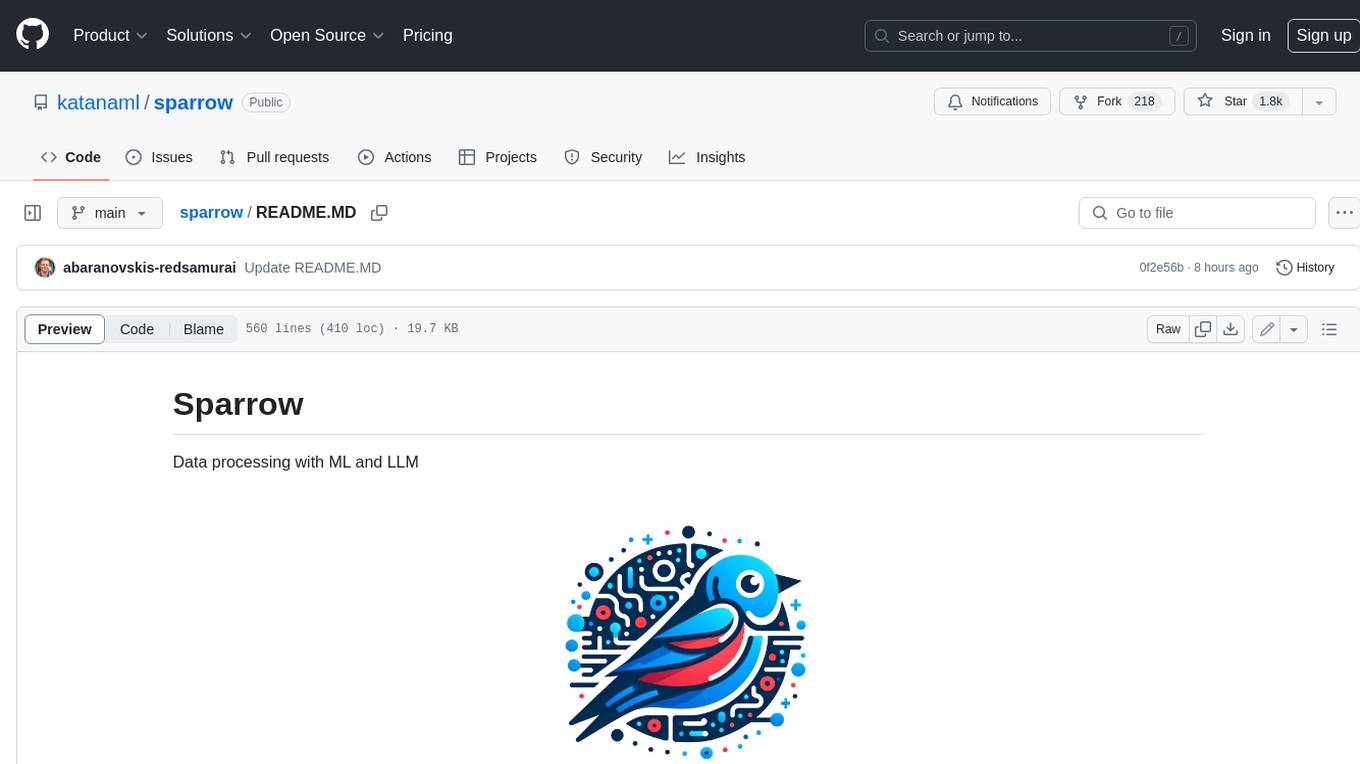
sparrow
Sparrow is an innovative open-source solution for efficient data extraction and processing from various documents and images. It seamlessly handles forms, invoices, receipts, and other unstructured data sources. Sparrow stands out with its modular architecture, offering independent services and pipelines all optimized for robust performance. One of the critical functionalities of Sparrow - pluggable architecture. You can easily integrate and run data extraction pipelines using tools and frameworks like LlamaIndex, Haystack, or Unstructured. Sparrow enables local LLM data extraction pipelines through Ollama or Apple MLX. With Sparrow solution you get API, which helps to process and transform your data into structured output, ready to be integrated with custom workflows. Sparrow Agents - with Sparrow you can build independent LLM agents, and use API to invoke them from your system. **List of available agents:** * **llamaindex** - RAG pipeline with LlamaIndex for PDF processing * **vllamaindex** - RAG pipeline with LLamaIndex multimodal for image processing * **vprocessor** - RAG pipeline with OCR and LlamaIndex for image processing * **haystack** - RAG pipeline with Haystack for PDF processing * **fcall** - Function call pipeline * **unstructured-light** - RAG pipeline with Unstructured and LangChain, supports PDF and image processing * **unstructured** - RAG pipeline with Weaviate vector DB query, Unstructured and LangChain, supports PDF and image processing * **instructor** - RAG pipeline with Unstructured and Instructor libraries, supports PDF and image processing. Works great for JSON response generation
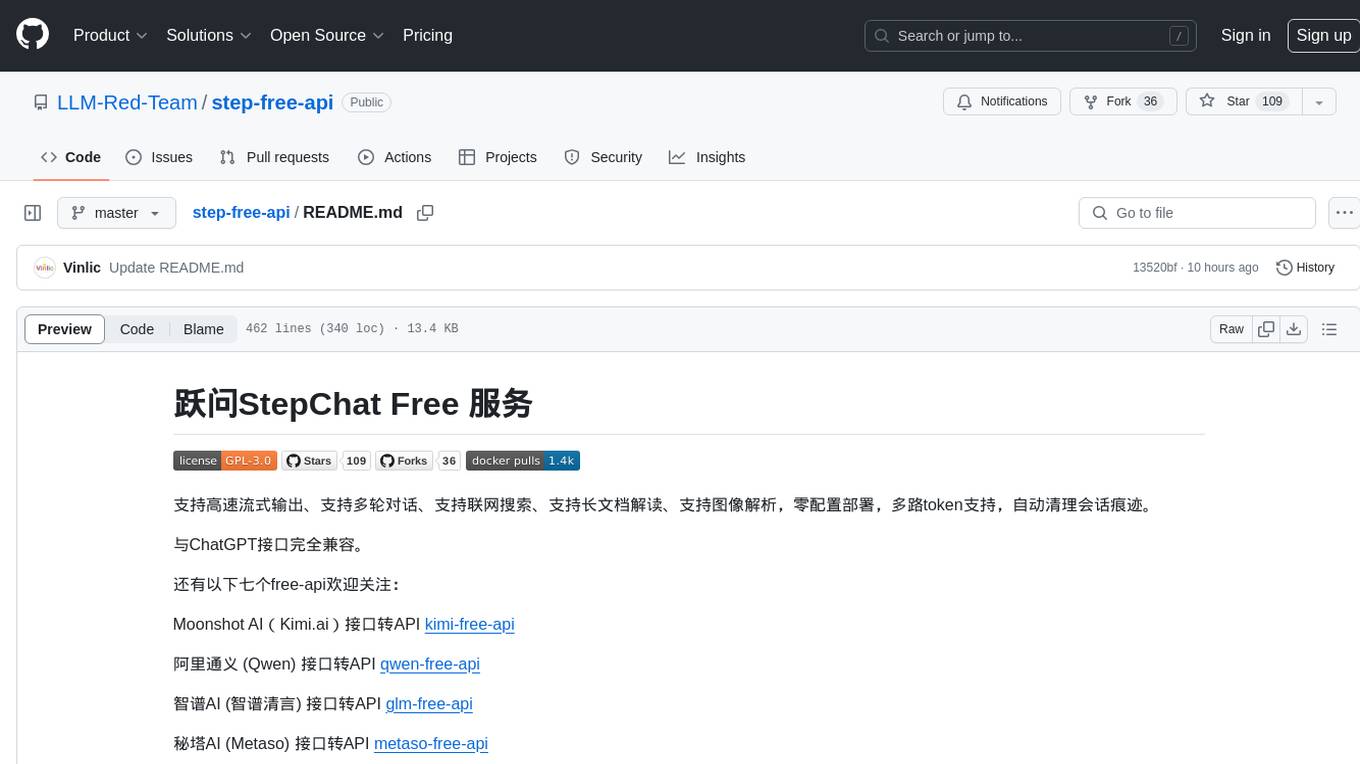
step-free-api
The StepChat Free service provides high-speed streaming output, multi-turn dialogue support, online search support, long document interpretation, and image parsing. It offers zero-configuration deployment, multi-token support, and automatic session trace cleaning. It is fully compatible with the ChatGPT interface. Additionally, it provides seven other free APIs for various services. The repository includes a disclaimer about using reverse APIs and encourages users to avoid commercial use to prevent service pressure on the official platform. It offers online testing links, showcases different demos, and provides deployment guides for Docker, Docker-compose, Render, Vercel, and native deployments. The repository also includes information on using multiple accounts, optimizing Nginx reverse proxy, and checking the liveliness of refresh tokens.
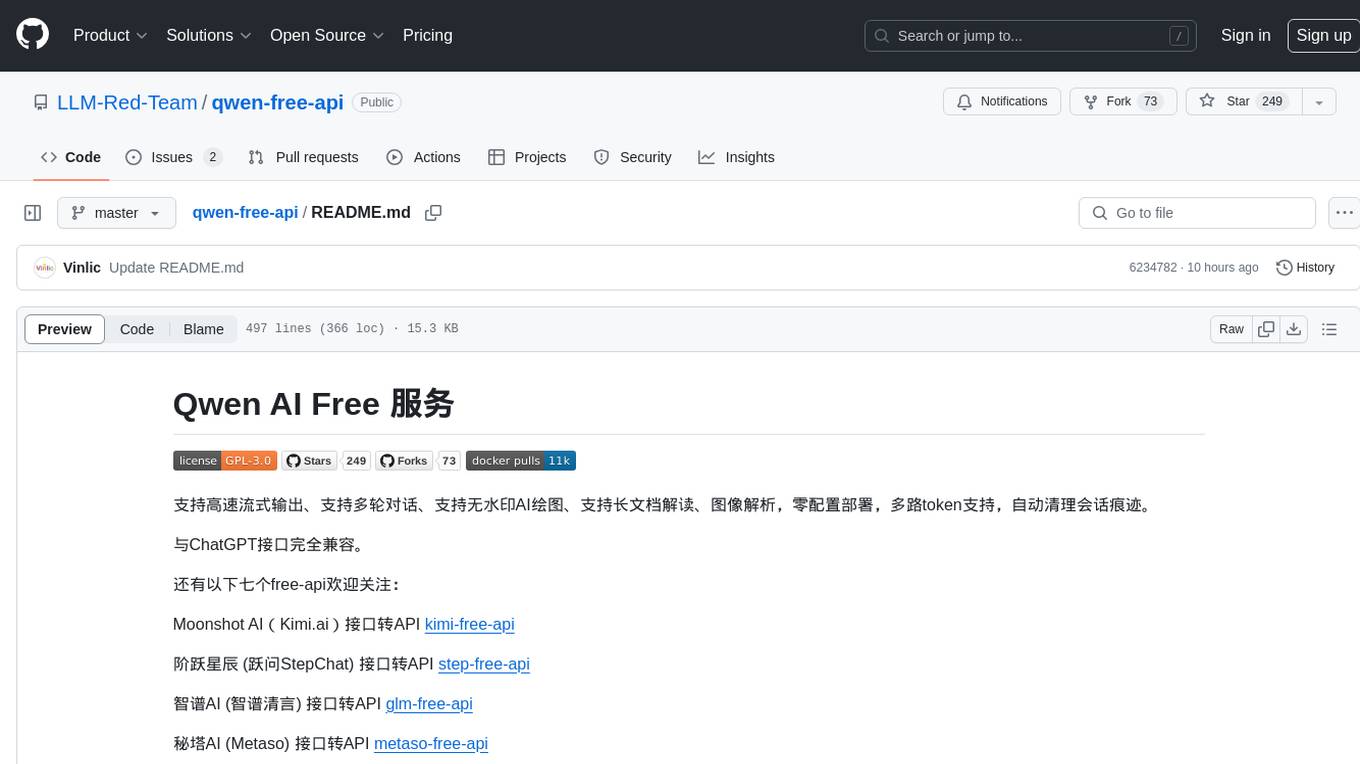
qwen-free-api
Qwen AI Free service supports high-speed streaming output, multi-turn dialogue, watermark-free AI drawing, long document interpretation, image parsing, zero-configuration deployment, multi-token support, automatic session trace cleaning. It is fully compatible with the ChatGPT interface. The repository provides various free APIs for different AI services. Users can access the service through different deployment methods like Docker, Docker-compose, Render, Vercel, and native deployment. It offers interfaces for chat completions, AI drawing, document interpretation, image parsing, and token checking. Users need to provide 'login_tongyi_ticket' for authorization. The project emphasizes research, learning, and personal use only, discouraging commercial use to avoid service pressure on the official platform.
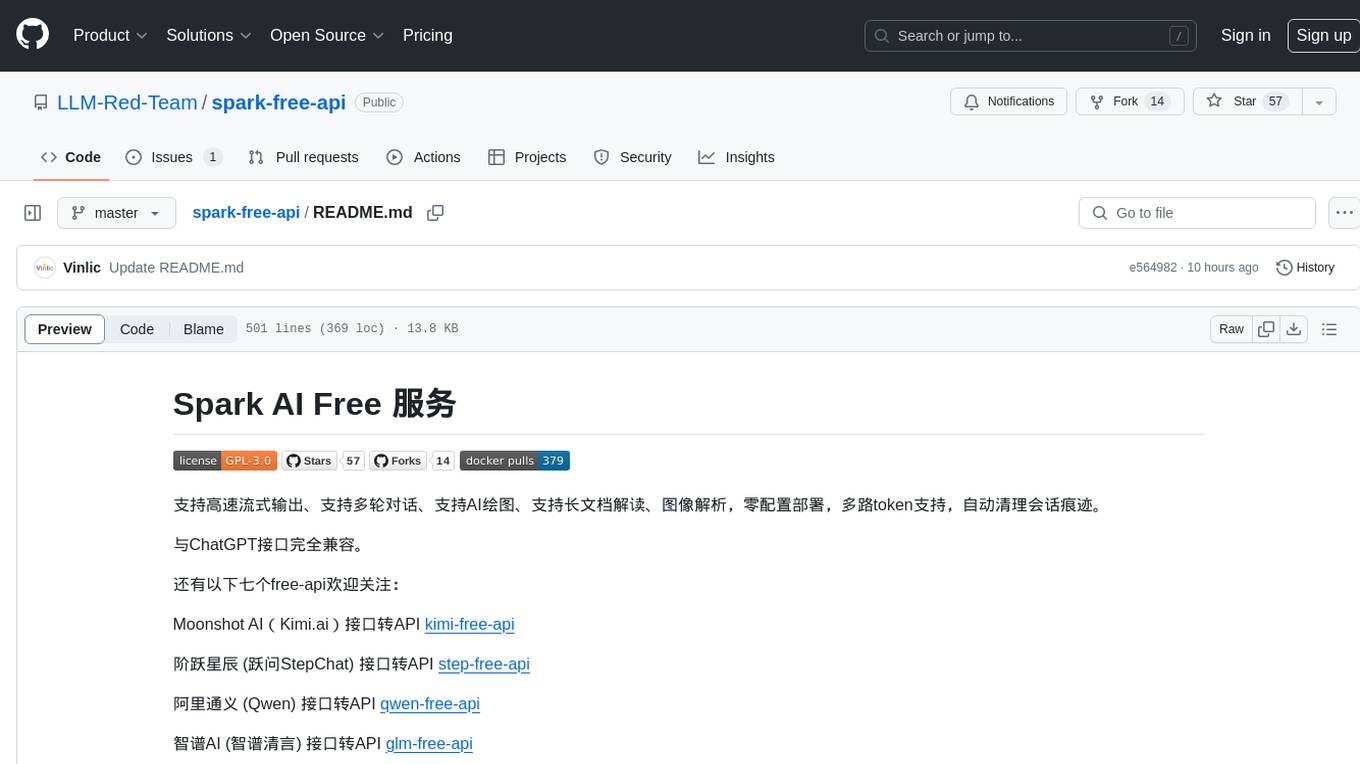
spark-free-api
Spark AI Free 服务 provides high-speed streaming output, multi-turn dialogue support, AI drawing support, long document interpretation, and image parsing. It offers zero-configuration deployment, multi-token support, and automatic session trace cleaning. It is fully compatible with the ChatGPT interface. The repository includes multiple free-api projects for various AI services. Users can access the API for tasks such as chat completions, AI drawing, document interpretation, image analysis, and ssoSessionId live checking. The project also provides guidelines for deployment using Docker, Docker-compose, Render, Vercel, and native deployment methods. It recommends using custom clients for faster and simpler access to the free-api series projects.
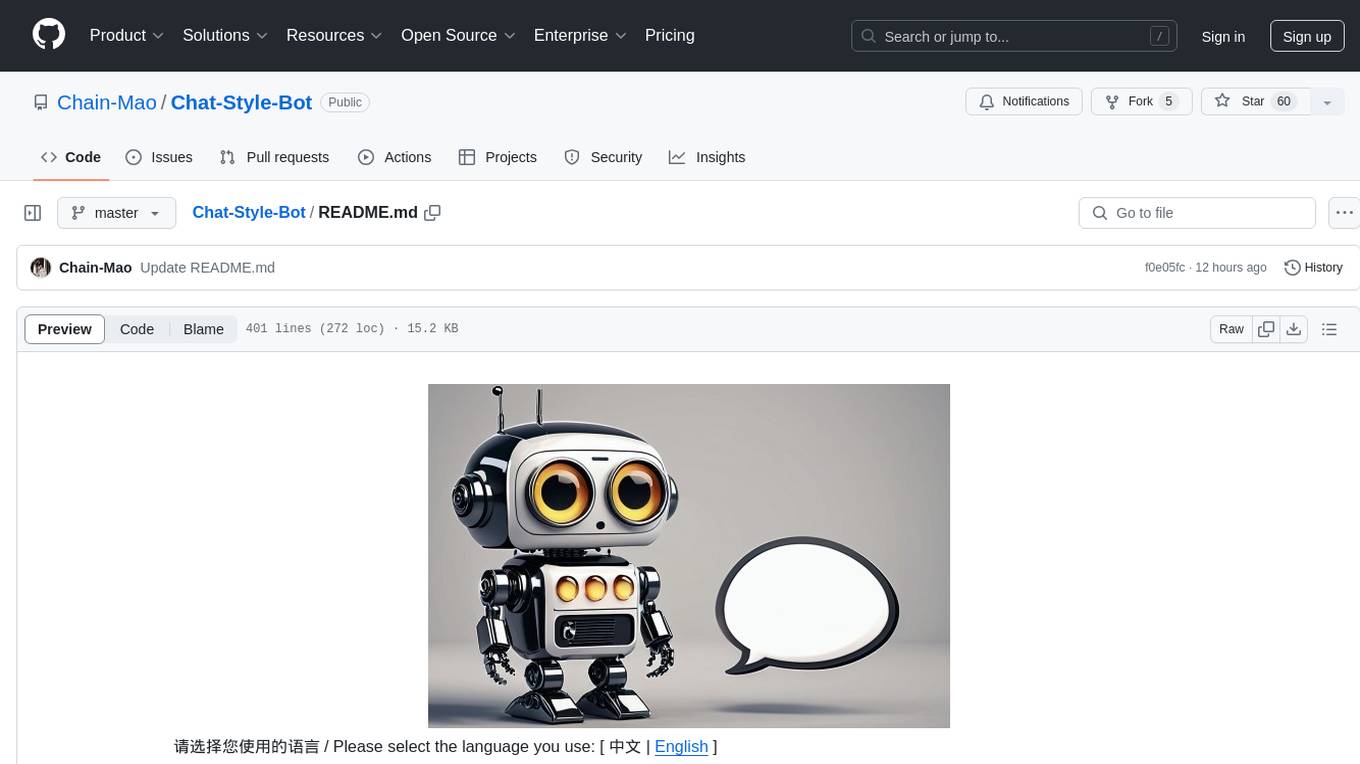
Chat-Style-Bot
Chat-Style-Bot is an intelligent chatbot designed to mimic the chatting style of a specified individual. By analyzing and learning from WeChat chat records, Chat-Style-Bot can imitate your unique chatting style and become your personal chat assistant. Whether it's communicating with friends or handling daily conversations, Chat-Style-Bot can provide a natural, personalized interactive experience.
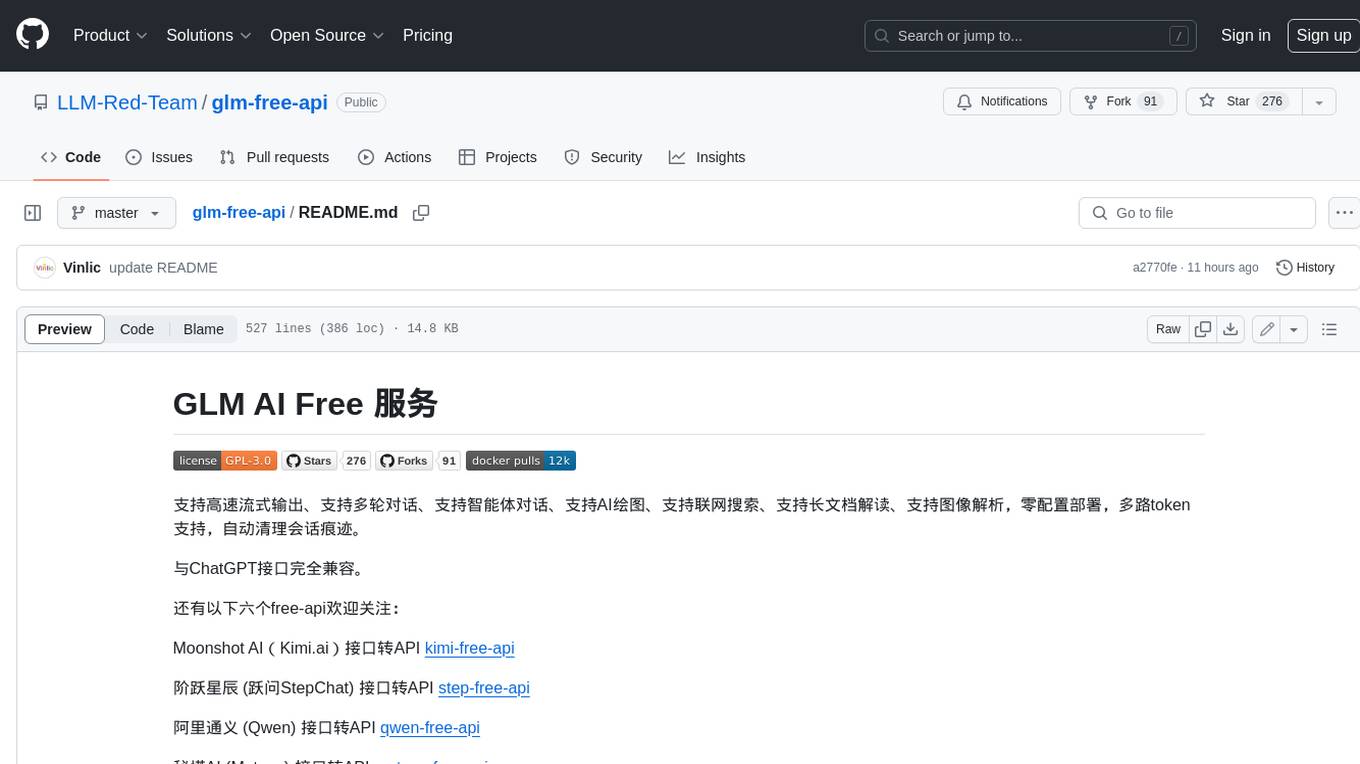
glm-free-api
GLM AI Free 服务 provides high-speed streaming output, multi-turn dialogue support, intelligent agent dialogue support, AI drawing support, online search support, long document interpretation support, image parsing support. It offers zero-configuration deployment, multi-token support, and automatic session trace cleaning. It is fully compatible with the ChatGPT interface. The repository also includes six other free APIs for various services like Moonshot AI, StepChat, Qwen, Metaso, Spark, and Emohaa. The tool supports tasks such as chat completions, AI drawing, document interpretation, image parsing, and refresh token survival check.
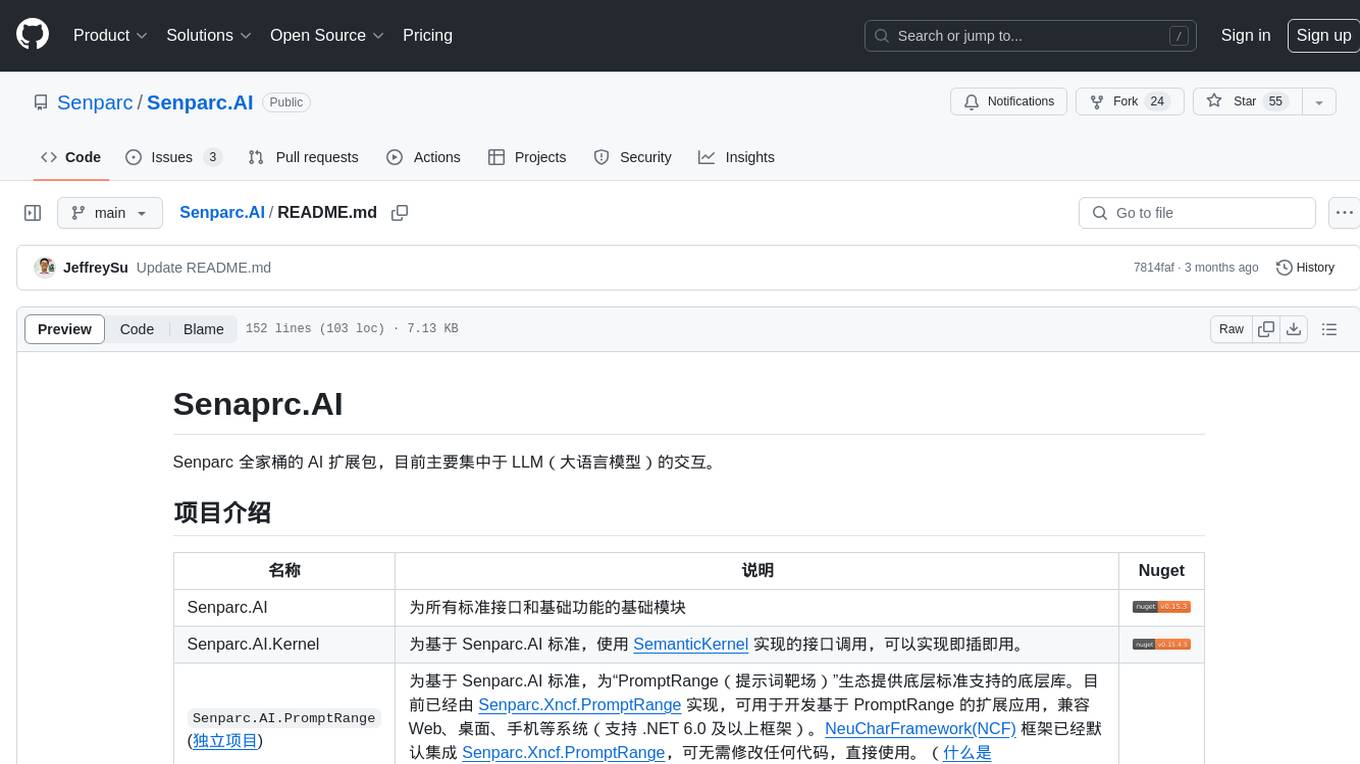
Senparc.AI
Senparc.AI is an AI extension package for the Senparc ecosystem, focusing on LLM (Large Language Models) interaction. It provides modules for standard interfaces and basic functionalities, as well as interfaces using SemanticKernel for plug-and-play capabilities. The package also includes a library for supporting the 'PromptRange' ecosystem, compatible with various systems and frameworks. Users can configure different AI platforms and models, define AI interface parameters, and run AI functions easily. The package offers examples and commands for dialogue, embedding, and DallE drawing operations.
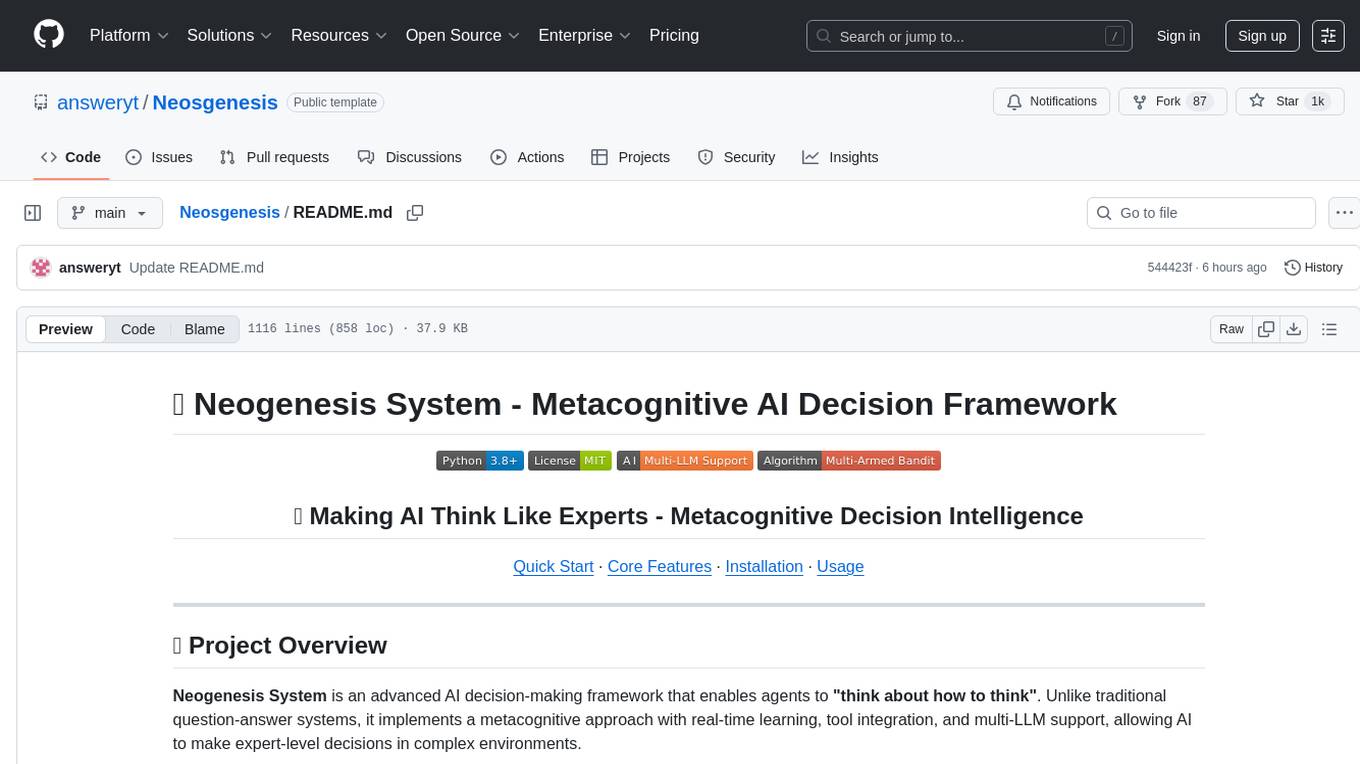
Neosgenesis
Neogenesis System is an advanced AI decision-making framework that enables agents to 'think about how to think'. It implements a metacognitive approach with real-time learning, tool integration, and multi-LLM support, allowing AI to make expert-level decisions in complex environments. Key features include metacognitive intelligence, tool-enhanced decisions, real-time learning, aha-moment breakthroughs, experience accumulation, and multi-LLM support.
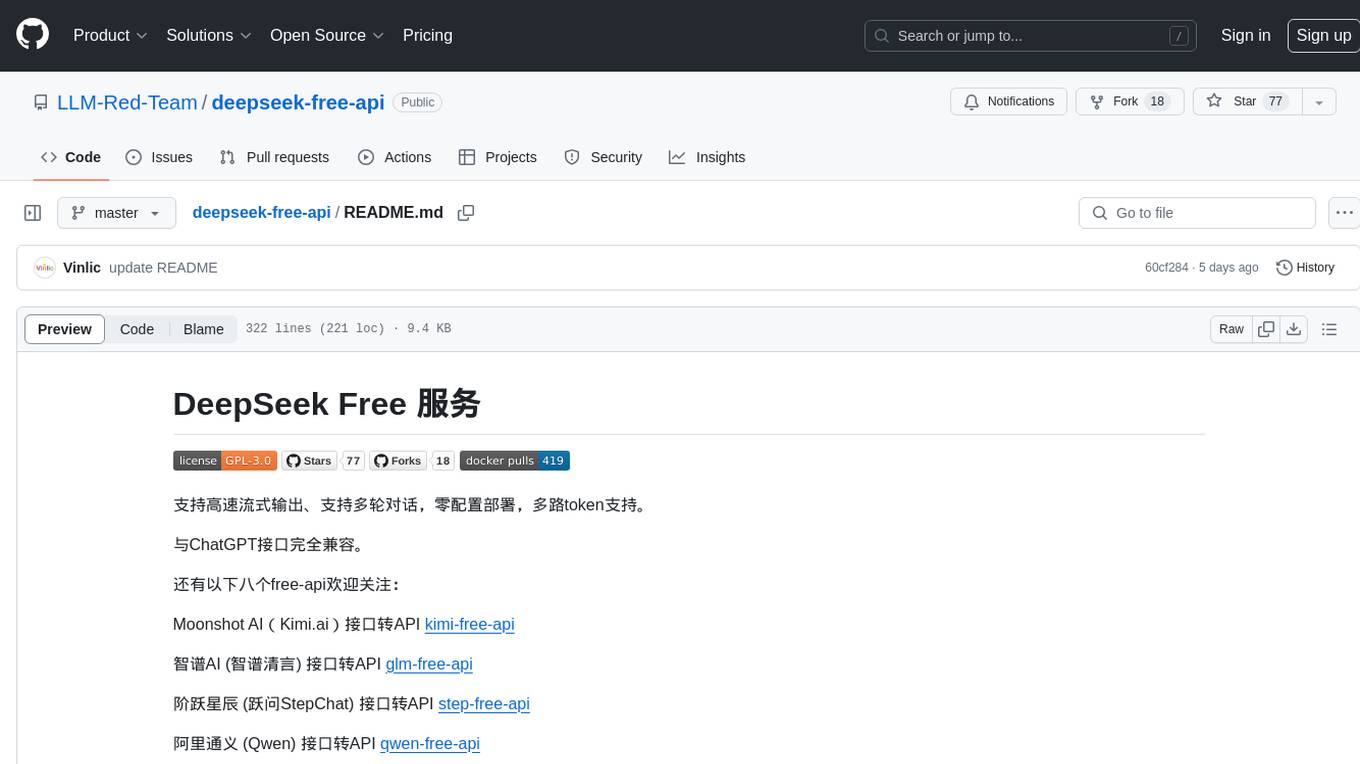
deepseek-free-api
DeepSeek Free API is a high-speed streaming output tool that supports multi-turn conversations and zero-configuration deployment. It is compatible with the ChatGPT interface and offers multiple token support. The tool provides eight free APIs for various AI interfaces. Users can access the tool online, prepare for integration, deploy using Docker, Docker-compose, Render, Vercel, or native deployment methods. It also offers client recommendations for faster integration and supports dialogue completion and userToken live checks. The tool comes with important considerations for Nginx reverse proxy optimization and token statistics.
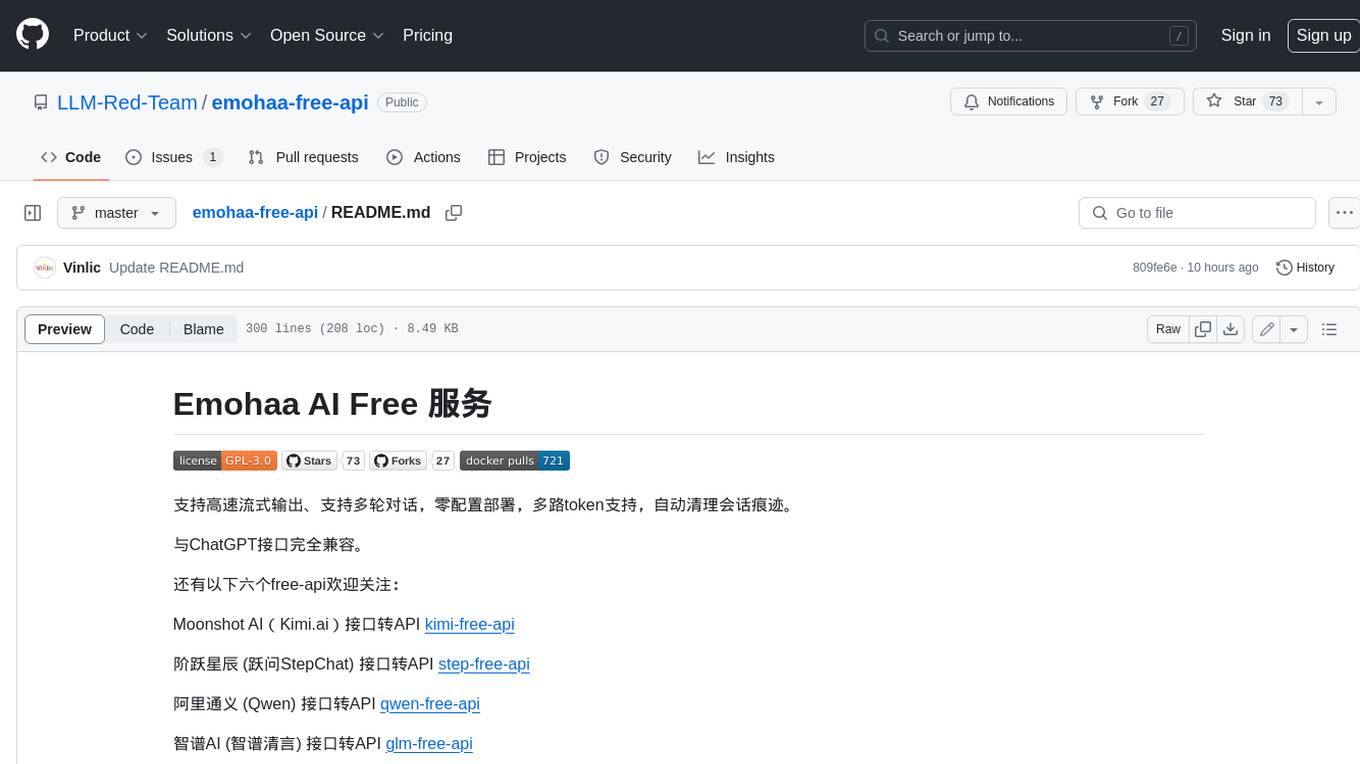
emohaa-free-api
Emohaa AI Free API is a free API that allows you to access the Emohaa AI chatbot. Emohaa AI is a powerful chatbot that can understand and respond to a wide range of natural language queries. It can be used for a variety of purposes, such as customer service, information retrieval, and language translation. The Emohaa AI Free API is easy to use and can be integrated into any application. It is a great way to add AI capabilities to your projects without having to build your own chatbot from scratch.
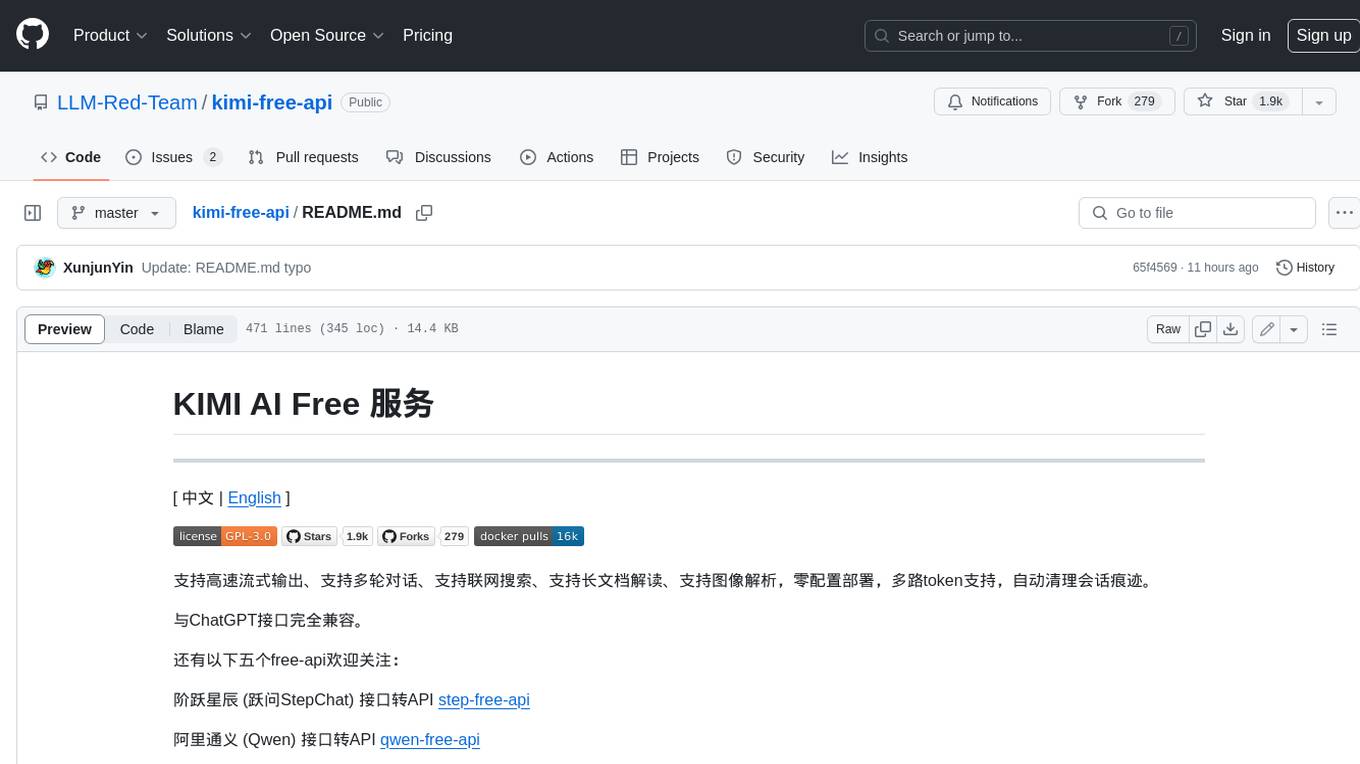
kimi-free-api
KIMI AI Free 服务 支持高速流式输出、支持多轮对话、支持联网搜索、支持长文档解读、支持图像解析,零配置部署,多路token支持,自动清理会话痕迹。 与ChatGPT接口完全兼容。 还有以下五个free-api欢迎关注: 阶跃星辰 (跃问StepChat) 接口转API step-free-api 阿里通义 (Qwen) 接口转API qwen-free-api ZhipuAI (智谱清言) 接口转API glm-free-api 秘塔AI (metaso) 接口转API metaso-free-api 聆心智能 (Emohaa) 接口转API emohaa-free-api
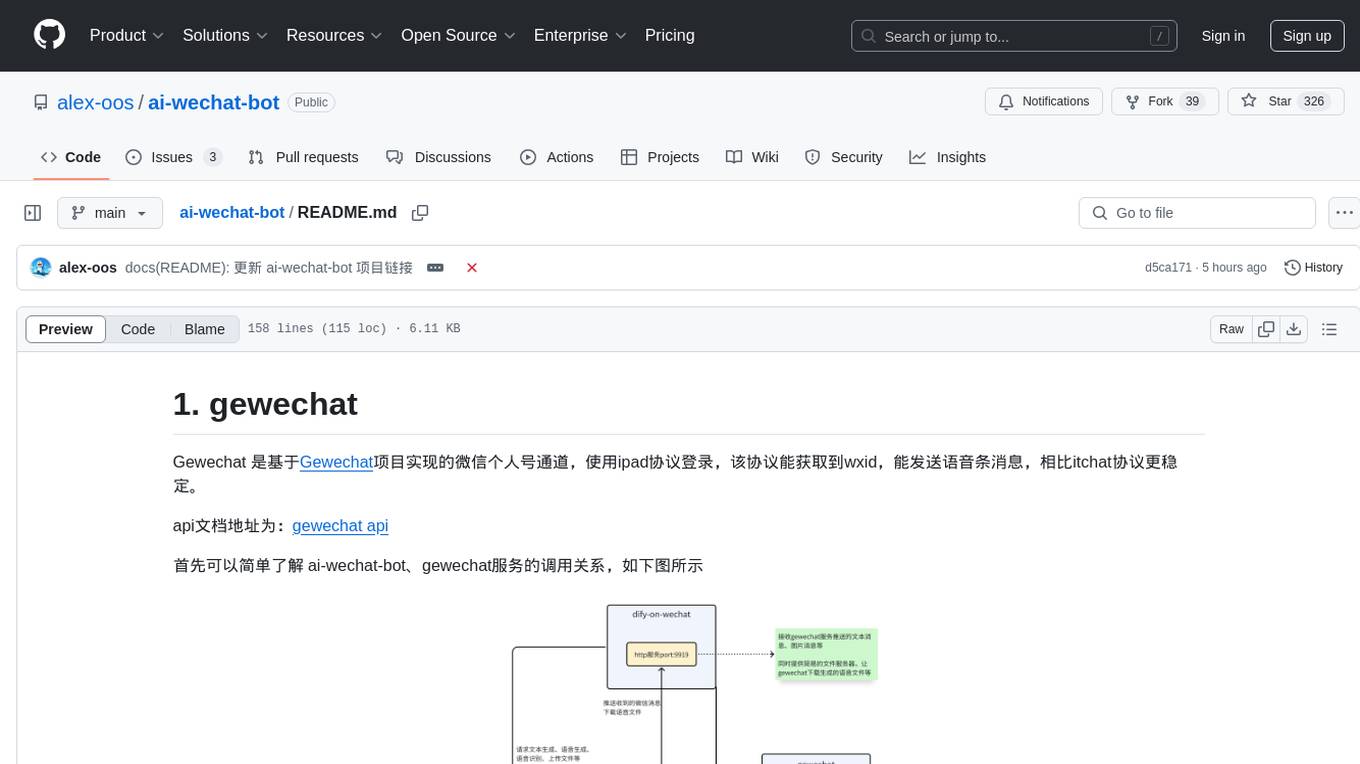
ai-wechat-bot
Gewechat is a project based on the Gewechat project to implement a personal WeChat channel, using the iPad protocol for login. It can obtain wxid and send voice messages, which is more stable than the itchat protocol. The project provides documentation for the API. Users can deploy the Gewechat service and use the ai-wechat-bot project to interface with it. Configuration parameters for Gewechat and ai-wechat-bot need to be set in the config.json file. Gewechat supports sending voice messages, with limitations on the duration of received voice messages. The project has restrictions such as requiring the server to be in the same province as the device logging into WeChat, limited file download support, and support only for text and image messages.
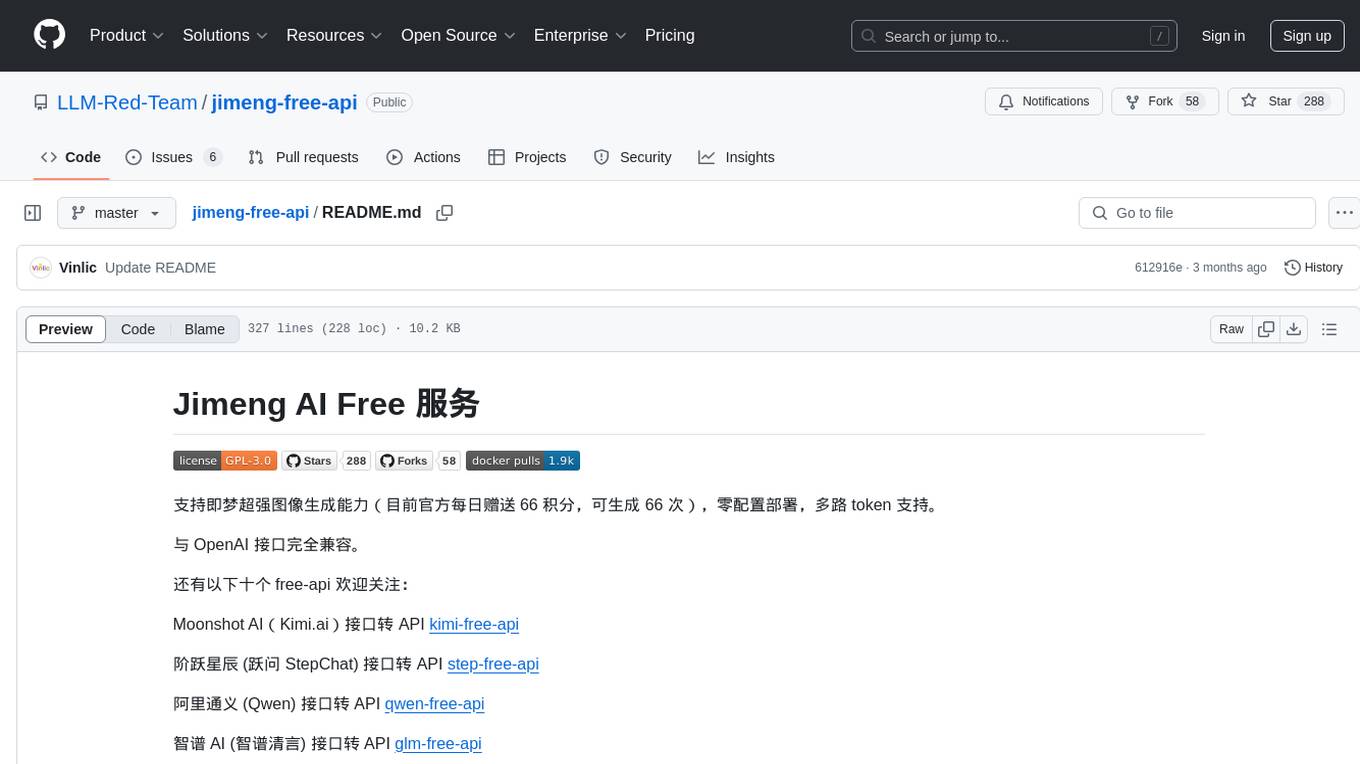
jimeng-free-api
Jimeng AI Free service provides powerful image generation capabilities with zero configuration deployment and support for multiple tokens. It is fully compatible with the OpenAI interface. The repository also includes other free APIs like Moonshot AI, StepChat, Qwen, GLM AI, Metaso AI, Doubao by ByteDance, Spark by Xunfei, Hailuo AI, DeepSeek, and Emohaa AI. Users can access the service by obtaining a sessionid from Jimeng and using it as a Bearer Token in the Authorization header for API requests. The service supports chat completions and image generations, with different models and parameters available for customization. Various deployment options are provided, including Docker, Docker-compose, Render, Vercel, and native deployment. Users are advised to use the recommended client applications for faster and simpler access to the free API services.
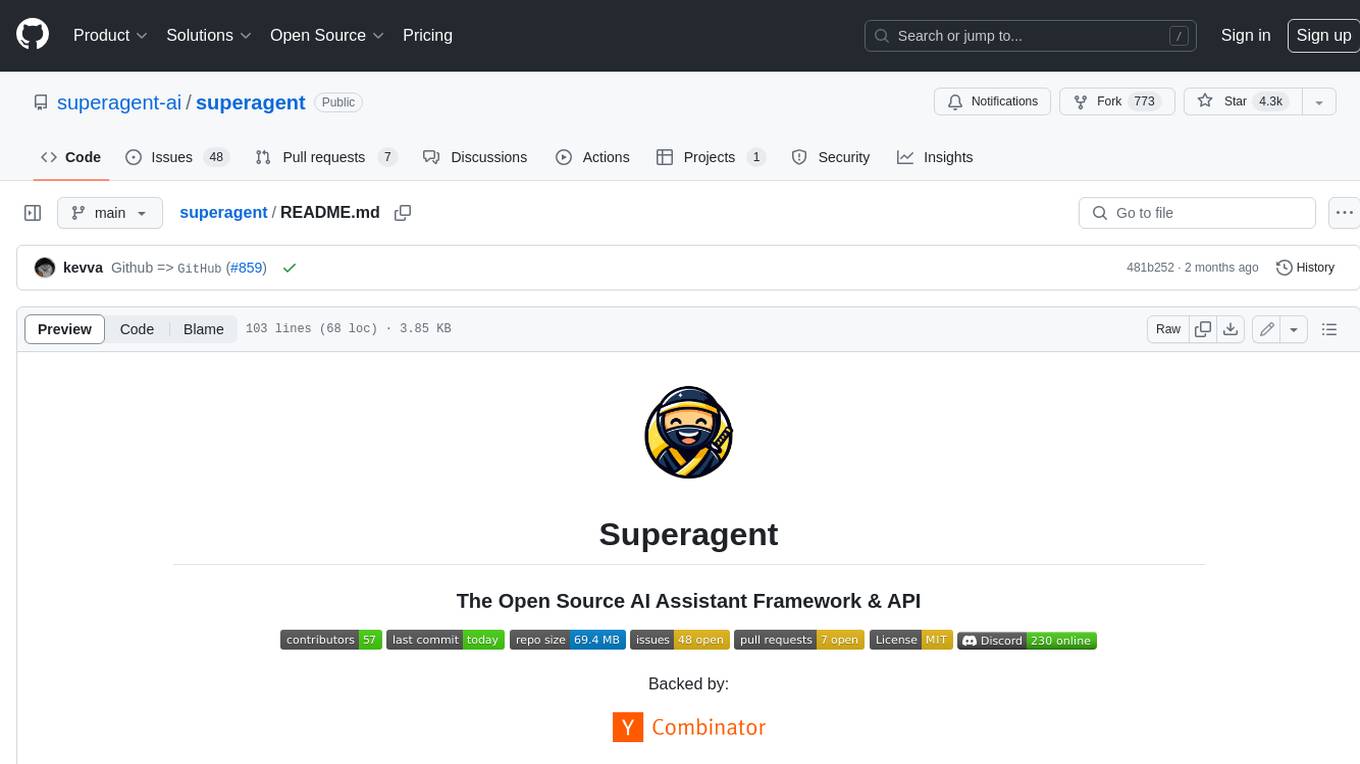
superagent
Superagent is an open-source AI assistant framework and API that allows developers to add powerful AI assistants to their applications. These assistants use large language models (LLMs), retrieval augmented generation (RAG), and generative AI to help users with a variety of tasks, including question answering, chatbot development, content generation, data aggregation, and workflow automation. Superagent is backed by Y Combinator and is part of YC W24.
For similar tasks

Gensokyo-llm
Gensokyo-llm is a tool designed for Gensokyo and Onebotv11, providing a one-click solution for large models. It supports various Onebotv11 standard frameworks, HTTP-API, and reverse WS. The tool is lightweight, with built-in SQLite for context maintenance and proxy support. It allows easy integration with the Gensokyo framework by configuring reverse HTTP and forward HTTP addresses. Users can set system settings, role cards, and context length. Additionally, it offers an openai original flavor API with automatic context. The tool can be used as an API or integrated with QQ channel robots. It supports converting GPT's SSE type and ensures memory safety in concurrent SSE environments. The tool also supports multiple users simultaneously transmitting SSE bidirectionally.
For similar jobs

sweep
Sweep is an AI junior developer that turns bugs and feature requests into code changes. It automatically handles developer experience improvements like adding type hints and improving test coverage.

teams-ai
The Teams AI Library is a software development kit (SDK) that helps developers create bots that can interact with Teams and Microsoft 365 applications. It is built on top of the Bot Framework SDK and simplifies the process of developing bots that interact with Teams' artificial intelligence capabilities. The SDK is available for JavaScript/TypeScript, .NET, and Python.

ai-guide
This guide is dedicated to Large Language Models (LLMs) that you can run on your home computer. It assumes your PC is a lower-end, non-gaming setup.

classifai
Supercharge WordPress Content Workflows and Engagement with Artificial Intelligence. Tap into leading cloud-based services like OpenAI, Microsoft Azure AI, Google Gemini and IBM Watson to augment your WordPress-powered websites. Publish content faster while improving SEO performance and increasing audience engagement. ClassifAI integrates Artificial Intelligence and Machine Learning technologies to lighten your workload and eliminate tedious tasks, giving you more time to create original content that matters.

chatbot-ui
Chatbot UI is an open-source AI chat app that allows users to create and deploy their own AI chatbots. It is easy to use and can be customized to fit any need. Chatbot UI is perfect for businesses, developers, and anyone who wants to create a chatbot.

BricksLLM
BricksLLM is a cloud native AI gateway written in Go. Currently, it provides native support for OpenAI, Anthropic, Azure OpenAI and vLLM. BricksLLM aims to provide enterprise level infrastructure that can power any LLM production use cases. Here are some use cases for BricksLLM: * Set LLM usage limits for users on different pricing tiers * Track LLM usage on a per user and per organization basis * Block or redact requests containing PIIs * Improve LLM reliability with failovers, retries and caching * Distribute API keys with rate limits and cost limits for internal development/production use cases * Distribute API keys with rate limits and cost limits for students

uAgents
uAgents is a Python library developed by Fetch.ai that allows for the creation of autonomous AI agents. These agents can perform various tasks on a schedule or take action on various events. uAgents are easy to create and manage, and they are connected to a fast-growing network of other uAgents. They are also secure, with cryptographically secured messages and wallets.

griptape
Griptape is a modular Python framework for building AI-powered applications that securely connect to your enterprise data and APIs. It offers developers the ability to maintain control and flexibility at every step. Griptape's core components include Structures (Agents, Pipelines, and Workflows), Tasks, Tools, Memory (Conversation Memory, Task Memory, and Meta Memory), Drivers (Prompt and Embedding Drivers, Vector Store Drivers, Image Generation Drivers, Image Query Drivers, SQL Drivers, Web Scraper Drivers, and Conversation Memory Drivers), Engines (Query Engines, Extraction Engines, Summary Engines, Image Generation Engines, and Image Query Engines), and additional components (Rulesets, Loaders, Artifacts, Chunkers, and Tokenizers). Griptape enables developers to create AI-powered applications with ease and efficiency.


